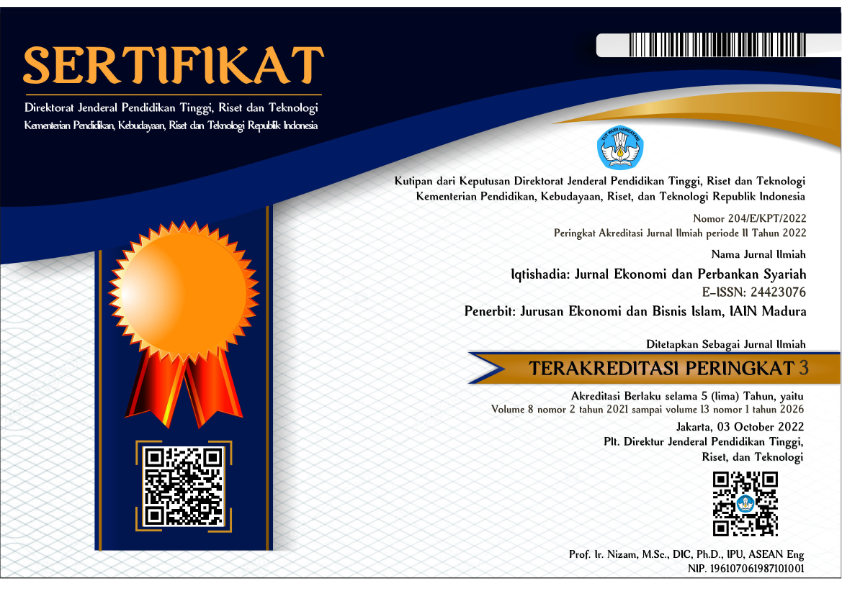Trade-off between Outreach and Profitability in Microfinance Institutions: Evidence from Bangladesh
 Abstract views: 288
,
Abstract views: 288
,
 PDF downloads: 294
PDF downloads: 294
Abstract
Claims have been made that the purpose of microfinance is to alleviate poverty and remain sustainable. Hence, there is a trade-off between outreach to the low-income community and financial profitability. This research study tried to examine the trade-off between outreach and profitability of microfinance institutions in the context of Bangladesh. This study uses a data sample of 433 Microfinance Institutions obtained from the Microcredit Regulatory Authority on Microfinance Institutions in Bangladesh. Factors that significantly influence the outreach are the Total number of borrowers and Loan size to borrowers, while the profitability, is Equity to asset and Total assets. The result shows that there is significant evidence of a trade-off between outreach and profitability in Microfinance Institutions in Bangladesh. Furthermore, the paper recommends Microfinance Institutions remain small in order to maximize their outreach and urges policymakers to develop robust regulations on microfinance to help the poor community and support the nation’s economy for long-term prosperity.
Downloads
References
Abdulai, A., & Tewari, D. D. (2017). Trade-off between outreach and sustainability of microfinance institutions: evidence from sub-Saharan Africa. Enterprise Development & Microfinance, 28(3), 162–181. https://doi.org/https://doi.org/10.3362/1755-1986.16-00014
Ahlin, C., Lin, J., & Maio, M. (2011). Where does microfinance flourish? Microfinance institution performance in macroeconomic context. Journal of Development Economics, 95(2), 105–120. https://doi.org/https://doi.org/10.1016/j.jdeveco.2010.04.004
Ahmed, I., Bhuiyan, A. B., Said, J., & Salleh, M. F. M. (2014). Breadth of Outreach and Accountability of Microfinance Institutions (MFIs) in South Asian Region. The Global Journal of Finance and Economics, 11(2), 161–173.
Athief, F. H. N. (2019). Embedding Crowdfunding Structure in Islamic Venture Capital for SMEs Development. Economica: Jurnal Ekonomi Islam, 10(1), 1–28.
Bos, J. W. B. , & Millone, M. (2015). Practice what you preach: Microfinance business models and operational efficiency. World Development, 70, 28–42. https://doi.org/https://doi.org/ 10.1016/ j.worlddev.2014.12.018
Caserta, M. , Monteleone, S. , & Reito, F. (2018). The trade-off between profitability and outreach in microfinance. Economic Modelling. https://doi.org/https://doi.org/10.1016/ j.econmod.2018.01.003
Conning, J. (1999). Outreach, sustainability and leverage in monitored and peer-monitored lending. Journal of Development Economics, 60, 51–77. https://doi.org/10.1016/S0304-3878(99)00036-X
Cull, R. , Demirgu¨ç-Kunt, A. , & Morduch, J. (2007). Financial performance and outreach: A global analysis of leading microbanks. The Economic Journal, 22, F107–F133. https://doi.org/https://doi.org/10.1111/j.1468-0297.2007.02017
Dorfleitner, G., Priberny, C., & Röhe, M. (2017). Why do microfinance institutions fail socially? A global empirical examination. Finance Research Letters, 22, 81–89. https://doi.org/https://doi.org/10.1016/j.frl.2016.12.027
El Ashfahany, A., Hanifa, S., Hidayana, N., Noor, M., & Fuzi, A. (2022). Challenges and Strategies in Using Sharia Crowdfunding and Sukuk for Micro and Small Medium Enterprises (MSMEs) Acceleration. An-Nisbah: Jurnal Ekonomi Syariah, 09(02).
Faruqee, R., & Badruddoza, S. (2012). Microfinance in Bangladesh: Past, Present and Future (in Bangla). https://scholars.ttu.edu/en/publications/microfinance-in-bangladesh-past-present-and-future-in-bangla
Hermes, N., & Lensink, R. (2011). Microfinance: Its Impact, Outreach, and Sustainability. World Development, 39(6), 875–881. https://doi.org/https://doi.org/10.1016/ j.worlddev.2009.10.021
Honohan, P. (2004). Financial sector policy and the poor: Selected findings and issues (Vol. 43). World Bank Publications.
Imai, K. S., Gaiha, R., Thapa, G., & Annim, S. K. (2012). Microfinance and Poverty—A Macro Perspective. World Development, 40(8), 1675–1689. https://doi.org/https://doi.org/ 10.1016 /j.worlddev.2012.04.013
Jia, X., Cull, R., Guo, P., & Ma, T. (2016). Commercialization and mission drift: Evidence from a large Chinese microfinance institution. China Economic Review, 40, 17–32. https://doi.org/https://doi.org/10.1016/j.chieco.2016.05.007
Khandker, S. R. (1998). Fighting poverty with microcredit: experience in Bangladesh. In New York: Oxford University Press. Oxford University Press. https://www.cabdirect.org/cabdirect/ abstract/19991800156
Kyereboah-Coleman, A. (2007). The impact of capital structure on the performance of microfinance institutions. Journal of Risk Finance, 8(1), 56–71. https://doi.org/https://doi.org/10.1108/15265940710721082
Latifah, S. W., & Yulianti, U. (2019). Dimensi Kompetitif Lingkungan Rantai Pasokan Upaya Mencapai Keunggulan Bersaing UMKM di Malang. BENEFIT Jurnal Manajemen Dan Bisnis, 4(1). https://journals.ums.ac.id/index.php/benefit/article/view/7355
Mazumder, M. S. U., & Lu, W. (2015). What impact does microfinance have on rural livelihood? A comparison of governmental and non-governmental microfinance programs in Bangladesh. World Development, 336–354. https://doi.org/10.1016/j.worlddev.2014.12.002
Megicks, P., Mishra, A., & Lean, J. (2005). Enhancing microfinance outreach through market-oriented new service development in Indian regional rural banks. International Journal of Bank Marketing, 23(1), 107–125. https://doi.org/https://doi.org/10.1016/j.jbankfin. 2008.11.009
Mersland, R., & Øystein Strøm, R. (2009). Performance and governance in microfinance institutions. Journal of Banking & Finance, 33(4), 662–669. https://doi.org/ 10.1016/j.jbankfin.2008.11.009
Quayes, S. (2015). Outreach and performance of microfinance institutions: a panel analysis. Taylor & Francis, 47(18), 1909–1925. https://doi.org/10.1080/00036846.2014.1002891
Rahman, M. M., Khanam, R., & Nghiem, S. (2017). The effects of microfinance on women’s empowerment: New evidence from Bangladesh. International Journal of Social Economics, 44(12), 1745–1757. https://doi.org/10.1108/IJSE-02-2016-0070/FULL/HTML
Raihan, S., Osmani, S. R., & Khalily, M. B. (2017). The macro impact of microfinance in Bangladesh: A CGE analysis. Economic Modelling, 62, 1–15. https://www.sciencedirect.com/ science/article/pii/S026499931730007X
Saab, G. (2015). Micro financing and their “Mission drift” orientation the MENA region case. Procedia Economics and Finance 30, 790–796. https://www.sciencedirect.com/ science/article/pii/S2212567115013283
Samer, S., Majid, I., Rizal, S., Muhamad, M. R., Halim, S., & Rashid, N. (2015). The impact of microfinance on poverty reduction: Empirical evidence from Malaysian perspective. Procedia-Social and Behavioral Sciences 195, 721–728. https://www.sciencedirect.com/ science/article/pii/S1877042815038227
Setiyaningrum, A., Ramawati, Y., & Hidayat, H. (2022). Studi tentang Peran Entrepreneurial Marketing dalam Meningkatkan Business Performance UMKM di Masa Pandemi Covid-19. Benefit: Jurnal Manajemen Dan Bisnis, 7(1). https://journals.ums.ac.id/index.php/ benefit/article/view/16393
Wijesiri, M., Yaron, J., & Meoli, M. (2017). Assessing the financial and outreach efficiency of microfinance institutions: do age and size matter? Journal of Multinational Financial Management, 40, 63–76. https://www.sciencedirect.com/science/article/ pii/S1042444X17300609
Zerai, B., & Rani, L. (2012). Is There a Tradeoff between Outreach and Sustainability of Micro finance institutions? Evidence from Indian Microfinance Institutions (MFIs). European Journal of Business and Management, 4(2), 90-98. https://www.academia.edu/ download/13142174/11.Is_There_a_Tradeoff_between_Outreach_and_Sustainability_of_Micro_finance_institutions.pdf
The journal operates an Open Access policy under a Creative Commons Non-Commercial Share-Alike license. All articles published Open Access will be immediately and permanently free for everyone to read and download.
• Creative Commons Attribution-NonCommercial (CC-BY-NC)

Iqtishadia: Jurnal Ekonomi dan Perbankan Syariah by http://ejournal.iainmadura.ac.id/index.php/iqtishadia is licensed under a Creative Commons Attribution-NonCommercial 4.0 International License.
Based on a work at http://ejournal.iainmadura.ac.id.

























